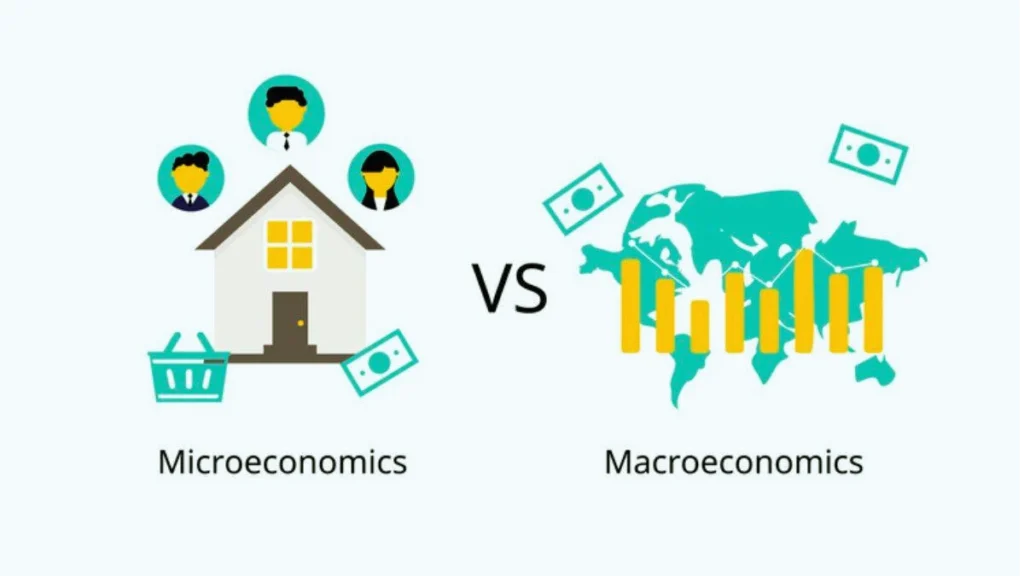What are the key differences between macroeconomics and microeconomics?
You must have heard the words macroeconomics and microeconomics in your economics course. What distinguishes Microeconomics From Macroeconomics ? Both are important branches of the economy, but in real life, their scope, focus and uses can be quite different. You can feel this difference at the personal level and Helps in and better understanding of how the economy works at the systematic level.
Table of Contents
ToggleThis guide explains the differences between macroeconomics and microeconomics, their everyday uses, and the five important theories that differentiate them. The article is a great resource for anyone interested in economics, whether you are a student or an academic researcher. A good place to start

Economic Decision Making Level
The level at which decisions are made is one of the most important differences between macro- and microeconomics.
Microeconomics: Business and Individual Analysis
The focus of microeconomics is on the smaller elements that make up an economy. The study of microeconomics focuses on the individual’s decision-making and how businesses and people allocate their limited resources. As an example:
- This is a good way to decide whether the family should spend money on summer holidays or save wealth for emergencies.
- What is the best way to price products so that the business can remain competitive and still earn more profits?
- What impact will rising gas prices have on consumer demand for electric cars?
Microeconomics is a branch of economics that focuses on the study of supply and demand. It also examines consumer behavior and market structure. This information helps policymakers, businesses and individuals to design strategies that meet the individual and market requirements.
The Big Picture of Macroeconomics
Macroeconomics operates on a larger scale. It is the study of aggregate economic phenomena and how policy can affect whole economies. Examples include:
- What is the impact of interest rates on national savings and investment?
- What policies can the government implement to end unemployment?
- What will be the long term effect of trade deficit on the economy of a country?
Macroeconomics takes a broader view of the economy, examining GDP (gross national product), unemployment, inflation and fiscal policy. Understanding the health of an economy and its direction is important.
Real-World Applications of Microeconomics and Macroeconomics
Microeconomics and macroeconomics both influence important aspects of our daily lives in different ways.
The Microeconomics in Action
Microeconomics is involved in every financial decision you make, whether it’s budgeting your groceries or choosing which streaming service to use. Microeconomics is used by businesses to determine their pricing, salaries and allocation of resources. For example, you can do this
- Starbucks sets the prices for its Holiday Drink Range based on anticipated demand trends.
- Analysis of subscription cancellation rates by streaming platforms is used to optimize pricing models.
Microeconomics helps businesses refine their strategies and make decisions that directly affect profitability.
Macroeconomics: Macroeconomics at Work
Macroeconomics is the science that explains all the major changes we see in the news, such as economic booms, recessions and policy changes. You can, for example:
- If governments implement stimulus plans in order to overcome economic recessions.
- What impact do central bank policies have on inflation and the interest rates charged for mortgages and loans?
- Global events such as trade wars and pandemics can have a ripple effect on the national economy.
These insights are crucial for government, international institutions and multinational companies that must respond to systemic changes in the economy.

Five Key Differences: What distinguishes Microeconomics From Macroeconomics
Let’s examine their five main differences now that we know how macroeconomics and microeconomics influence our lives.
1. Focus & Scope
- Microeconomics is a study of individuals, families, and small businesses.
- Macroeconomics includes national and international economic performance.
2. Answers to the Key Questions
- Microeconomics focuses on questions such as what influences consumer decisions between competing products and how much an organization should produce to maximize profits.
- The macroeconomics branch Broader is concerned with questions such as what causes a recession in economic growth and how the economy keeps inflation under control.
3. Tools and Metrics
- Microeconomics is concerned with the demand curves and production costs.
- Microeconomics analyzes GDP, unemployment rates, inflation figures and fiscal or monetary policies.
4. Stakeholders and Actors
- The focus of Microeconomics revolves around the decision-makers at a personal level or in business.
- Macroeconomics is a complex field that involves international organizations like the IMF and whole industries.
5. Dependency
- Macroeconomics theory often builds on microeconomics theory. Macroeconomics analyzes systematic trends by analyzing all individual behavior.
Micro and Macroeconomic Myths and Facts You May Not Know
When studying any field, it’s crucial to avoid common misunderstandings.
- Microeconomics is common sense: Although microeconomics is concerned with decisions made by individuals, deep analysis is often required.
- Macroeconomics may seem abstract. Keynesian or monetarist ideologies are often used to guide monetary and fiscal decisions.
- The two are not independent: Macro and Microeconomics. To get a complete understanding of an economy, it is most important to understand both perspectives.
Take Economics Theory from the Classroom to Practice
Economics is not just a theory. It’s also a way to solve real-world problems.
Try applying the concepts of economics to current events if you are an economist or enthusiast.
- Monitor how the micro-level purchasing decisions (micro) are affecting national issues in supply chains (macro).
- Watch how localized interest rate increases (macro), such as those in the housing industry, affect certain industries.
You can gain a better understanding of the economics of society by framing both areas as connected rather than separated.
Last Thoughts about Microeconomics and Macroeconomics
Both microeconomics and macroeconomics play an important role in understanding how the economy works, whether at the micro or macro level. Although their tools and perspectives are different, the ultimate goal of both is to improve decisions and outcomes at all levels. to improve

